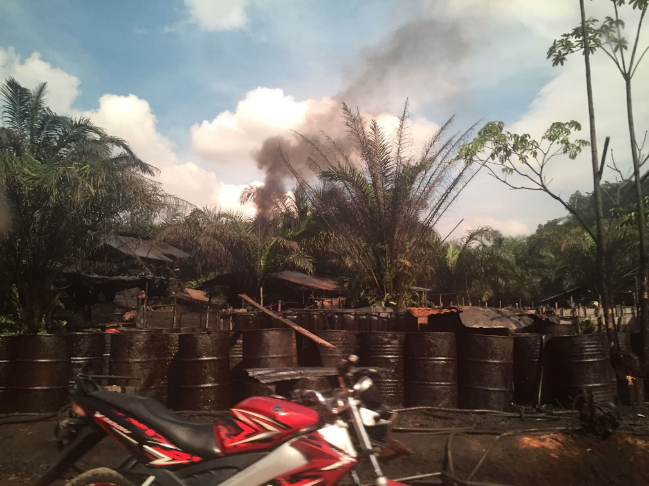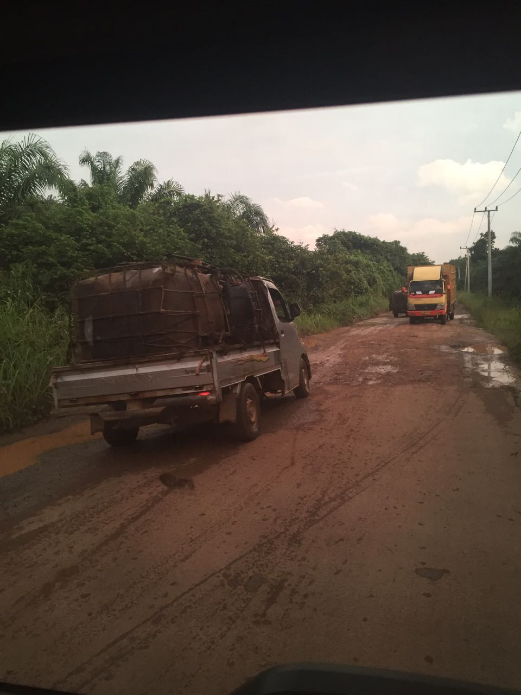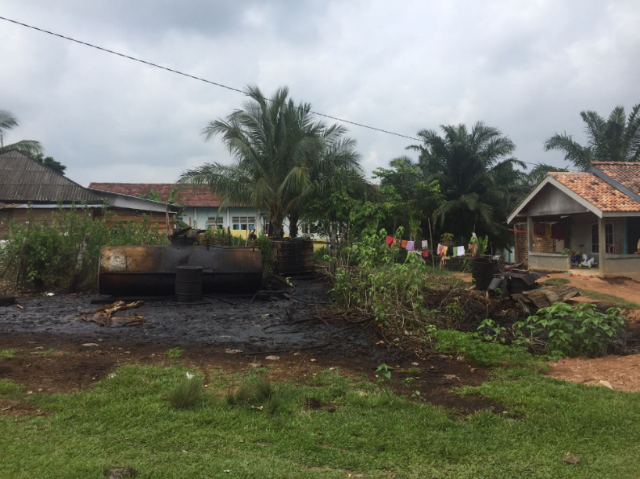Extraction Custom in Mangun Jaya Village, South Sumatra
By Hendrika Tiarma Wulandari Samosir, Researcher, WRI Indonesia.
Community life is greatly influenced by access to nearby natural resources. According to a source I met in the Mangun Jaya Village, Babat Toman District, Musi Banyuasin Regency, South Sumatra, the area was formerly forest. Wood, rattan, and honey are commodities the community takes to fulfil their daily needs. Hunting for wild animals such as tigers, lions, bears, deer, and pangolins can also improve one's economic standard. In addition to the forest, the community utilizes resources from the Musi River such as catfish, baung fish, lais fish, salam fish, and other small fish. Taking natural wealth rather than cultivating crops or livestock is usual.
Mangoes fenced in while goats roam outside
On the journey from Sekayu to Mangun Jaya, we were often surprised by herds of livestock on the highway. Having to stop and wait for the goat parades to pass was amusing; an attraction we rarely saw on inter-provincial roads on the island of Java.
Arriving in Mangun Jaya Village, I saw a mango plant in front of a resident’s house that was fenced. I raised this curiosity with the owner, who casually replied, "Yes, if it is not fenced, the cows and goats will eat it. Yes, I am aware, there's no point complaining to the livestock owner.” This reminded me of the herd in the middle of the road earlier. In addition to endangering road users, it turns out that roaming livestock also damage gardens, and in terms of cleanliness, leave a lot of animal waste on the village roads. What surprised me even more was that people were used to the phenomenon.
The question in my mind was why people didn't want or were not able to cage their livestock. From an economic point of view, building a cage is quite expensive; the community must have money to make it. The village did not have savings and loan institutions or cooperatives. People who needed capital often had to borrow from informal loan institutions that offer relatively high interest. At the same time, lending from banks was not an option for them due to complicated requirements. The habit of taking natural resources through extraction was not accompanied by the awareness of livestock cultivation. In addition to endangering drivers on the highway and polluting the environment, the selling price of these animals would not be as high as farmed livestock.
Crop cultivation was also not very visible in this area. Vegetables and fruit from the market were mostly supplied by transmigrant villages around Musi Banyuasin District. Low awareness of cultivation meant people in this area could not provide their daily needs from their own farms. Despite their relatively high dependence on natural resources, people were failing to think about the fate of the Mangun Jaya forests in the future. Forests in Mangun Jaya had been turned into rubber and oil palm plantations. Big companies were sucking the irrigation supply of rice fields with large canals. Forests were deforested, fish in the Musi River were becoming scarce, rice fields were drying up.
The situation has led to a new trend in this region; the majority of the Mangun Jaya community has taken up crude oil extraction.
Villagers try their luck with oil extraction
Crude oil extraction has increased in line with the community's needs for food and education. Failing rice fields in this area can no longer meet the demand for food in Mangun Jaya. People buy rice from other regions at a higher price. Schools in Mangun Jaya require parents to pay for tuition, books, and uniforms. Meanwhile, the rubber plantations yield little. This is exacerbated by the decline in the selling price of rubber, and land once used for rubber is being replaced with oil palm plantations.
In the oil drilling process, there are several economic actors, such as investors, oil drillers, oil refiners, carriers, and receivers.
To raise a large amount of capital required to drill for oil, residents form small groups of investors. Only luck determines where the drill will be plugged in. Like tossing a coin, the lucky groups will get big profits quickly, while the less fortunate will lose their investment or even have to bear the shame of leaving the village because of debt.
 Oil extraction in Mangun Jaya. Photo by Hendrika Tiarma Wulandari Samosir.
Oil extraction in Mangun Jaya. Photo by Hendrika Tiarma Wulandari Samosir.
Thick black smoke billowing high is a sign of an oil refiner in the area. The distillation process takes 10-12 hours. What usually comes out first is gasoline, then diesel, and finally kerosene. People who work in distilleries face high risks, and it is not uncommon for accidents to cause paralysis. Oil proceeds are channeled to a tauke (receiver), someone who has economic power and sometimes even has access to the formation of policy. They collect all of the existing petroleum refinings. The price set by tauke follows the world oil price at that time. The results from oil drilling will be transported using L300 cars which local people call tekmon.
 Tekmon. Photo by Hendrika Tiarma Wulandari Samosir.
Tekmon. Photo by Hendrika Tiarma Wulandari Samosir.
The extraction of oil resources offers significant and rapid benefits that encourage people to engage in high-risk activities. One success story will spread quickly in the village, and trigger others to try their luck.
However, something makes me sad about the condition of this village. Crude oil spilled around the drilling sites blackens the grass and plants, and then they are just abandoned. Drilling is carried out on vacant and farming land and severely damages the surrounding vegetation. If this drilling continues, I wonder what the next few decades hold for this area.
 An oil reservoir in Mangun Jaya Village which was abandoned by traditional drillers. Photo by Hendrika Tiarma Wulandari Samosir.
An oil reservoir in Mangun Jaya Village which was abandoned by traditional drillers. Photo by Hendrika Tiarma Wulandari Samosir.
The habits of people in Mangun Jaya are still dominated by a culture of extraction that takes natural resources directly without processing them. While they gain significant profits in the short-term, it is also important to remember that this practice is rapidly depleting natural wealth in the area.